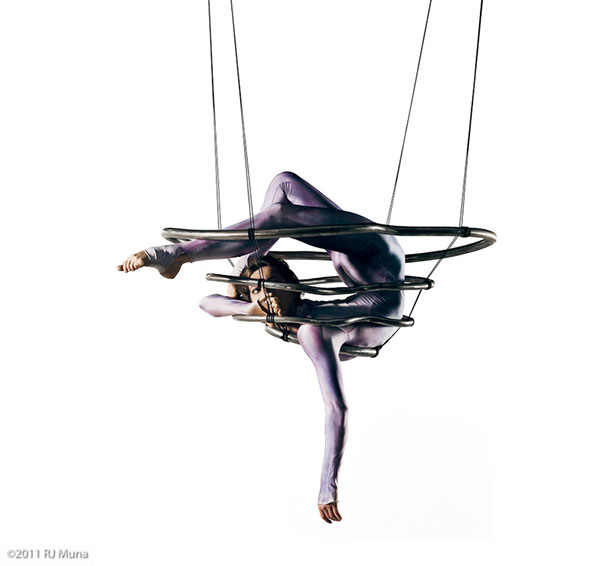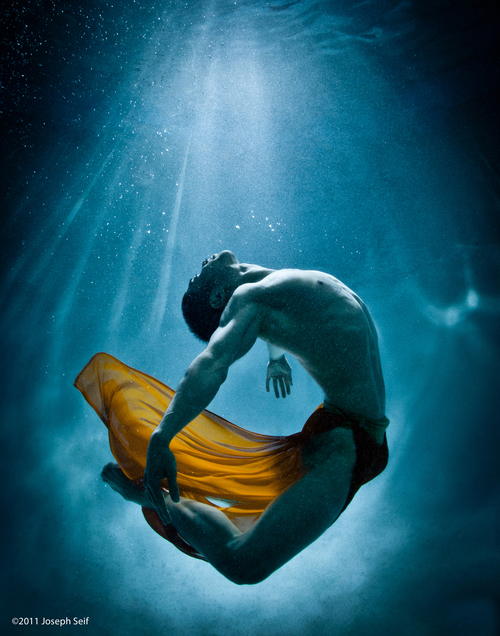Okeanos: A Performance Where Dancers Move Like Octopuses and Seahorses
Jodi Lomask, director of the dance company Capacitor, has choreographed an ocean-inspired show, now at San Francisco’s Aquarium of the Bay
/https://tf-cmsv2-smithsonianmag-media.s3.amazonaws.com/filer/20131105112017Okeanos-Joseph-Seif-web.jpg)
Circus performer and Mongolian-trained contortionist Inka Siefker practiced moving like a giant Pacific octopus at home. “I wiped off kitchen counters like my arm had tentacles, or used my leg to get something from the top of the refrigerator,” she says. “I have long legs.”
Siefker is one of seven performers in Okeanos: A Love Letter to the Sea, a live dance/cirque show created by Capacitor, a group that fuses art and science to connect people to their world. Capacitor performs Okeanos on stage, with dance, music, sculpture, aerialists and underwater film as a backdrop, in the Aquarium of the Bay‘s 255-seat theater at San Francisco’s Pier 39. It premiered with four performances in 2012 at Fort Mason’s Herbst Theater and then opened at the aquarium in August 2013 to play through the end of September. The show’s run has been extended and shows are scheduled for most Thursday and Saturday nights through December.
Jodi Lomask, artistic director of Capacitor, took three years to research, design and create Okeanos. She learned to surf and scuba dive and found inspiration in Capacitor Labs, where California Academy of Sciences oceanographers and marine biologists gave informal lectures to Lomask and company. Senior science advisor Tierney Thys, a National Geographic Explorer, explained the dynamics of tropical coral reefs and California kelp forests. Thys helped the dancers find narratives and move in ways that resembled the movements of marine plants and animals. Siefker learned from Thys that an octopus is floppy, and that it has nine brains, one for each arm that can move independently of the central brain.
Thys explained that tiny ocean creatures like copepods live in a completely different flow regime than larger animals like whales and dolphins. Flow regimes are described by an equation called the Reynolds number, which characterizes flow as laminate (smooth and parallel) or turbulent (disruptive with vortices). Animals that are millimeters in length operate at low Reynolds numbers, where water acts more like thick honey. Viscosity is a factor in the Reynolds equation, and Lomask and her dancers experienced the challenges of water’s viscosity by practicing their movements underwater. “It’s hard to hold onto someone while water moves and the weight of it is on top of you,” said Siefker, who practiced her seahorse dance with her contortionist partner, Elliot Goodwin Gittelsohn, in pools.
Lomask choreographed the seahorse dance (or so I call it) after Healy Hamilton, a biodiversity scientist at the California Academy of Sciences, described her work. “Seahorses are some of the most romantic creatures alive,” says Lomask, who invented a movement style to imitate the extreme posture of the seahorses. She hired contortionists who were better able to stylize the seahorse’s extended bellies, locked tails and daylong mating dance (which, for the seahorse, ends with the female transferring her eggs to the male’s pouch where the babies grow). In the show, the seahorses dance in front of Great Barrier Reef footage by filmmaker David Hannan. San Francisco cinematographer Joseph Seif shot the underwater dance film.
In another piece, Siefker swings from a hanging spiral structure. She could be a coral polyp, an anemone or a diatom. She swings in the same current, or beat, as a dancer on the floor below who is on his back with arms and legs swaying as if he is sea grass or kelp. The movement is familiar to anyone who has scuba dived, snorkeled, surfed or, actually, even walked through the glass-walled tunnels of the 707,000-gallon tank in the Aquarium of the Bay (next door to the theater) where sea kelp sway with bat rays, white sturgeon and sprays of silver sardines.
Lomask grew up with strong influences in both art and science. Before she was born, her father, Morton Lomask, was one of the scientists aboard the Bathyscaphe Trieste when it broke deep-ocean diving records in the Mediterranean Sea. (The Trieste broke another record three years later after it was redesigned by Americans and sent into the Mariana Trench.) Jodi grew up on 85 acres in the woods of Connecticut where her father built and ran a biomedical research equipment lab. Her mother, Joan Lomask, was a printmaker, sculptor and painter. “Science is the way I learn about the world. Art is the way I process what I have learned,” says Jodi.
The collision of art and science is apparent in the name of Lomask’s company. A capacitor is an electrical device that accumulates and stores electricity for a given release. “It’s a metaphor for the life of a performer,” she says. “You spend a long period of time creating work and then you release the energy all at once in the form of a performance.”
Lomask, who has also explored a forest canopy and the reproductive life of a flower through performance art, created Okeanos because she wanted to learn about the deep ocean. In the process, she realized that the health of the ocean is in crisis, with coral reefs being destroyed twice as fast as rain forests and plastic accounting for 90 percent of all pollution in the ocean. Lomask changed her habits as a consumer. She eats less seafood, and when she does she makes sure it is sustainable, and she no longer uses single-use plastic. She hopes that her audiences will do the same and lists ten things on the program that people can do, such as supporting Marine Protected Areas and lowering carbon footprints, to protect ocean life.
“All living things are sea creatures, including humans,” says Sylvia Earle, an advisor on the project, in the show’s narration. ”Imagine Earth without an ocean. Imagine life without an ocean. The single non-negotiable thing that life requires is water. Take away the ocean and take away life.”


